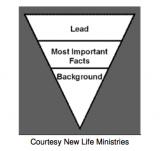COMMUNICATE LIKE EARNEST HEMMINGWAY
Recently an outstanding plaintiff’s attorney shared the report of an obituary about a talented reporter and writer Pete Hamill.
https://www.nytimes.com/2020/08/05/nyregion/pete-hamill-dead.html The key to Hamill’s writing skill was noted in the obituary where it reported: “He idolized Hemingway.” Hemmingway’s writing style was brevity and simplicity with powerful words that dispensed with adjectives and got straight to the point.
There is much lawyers can learn from Hemingway’s writing style. Lawyers are afflicted with the curse of lacking an awareness of the difference between the important and relevant from the unimportant and irrelevant. They either lack the skill to do so or are too lazy to make the effort.
One of the most fundamental differences between journalism and other forms of writing is the way journalists obtain the information they write about. Journalists obtain information through a variety of reporting techniques, which can include interviewing sources, looking through government documents, researching old articles, and observing events firsthand.
Good news writing begins with good, accurate reporting. Journalists perform a public service for citizens by presenting truthful facts in honest, straight-forward articles. In a blog regarding news reporting, First News Education, https://schools.firstnews.co.uk/blog/journalistic-writing/top-ten-tips-for-writing-a-newspaper-report/, there is an excellent outline about how to correctly and properly write a news report. The instructions are very relevant to the rules for lawyers in advocacy either an argument or in writing. These rules are:
A news report should be about something that is happening now or recently occurred. Current issues, key events and crimes make good subjects for news reports.
The opening paragraph should be concise and explain the full story in as few words as possible. Even if someone reads no further, they should know what has happened.
Newspaper articles are written so the information is given in order of importance with each preceding paragraph including more detail. This style of writing is called The Inverted Pyramid where the most important information is in the lead paragraph. If reports end up being too long for the newspaper, they should always be able to be cut from the bottom.

Have they answered WHAT happened? WHEN did it happen? WHY did it happen? WHERE did it happen? WHO did it happen to? HOW did it happen?
Including quotes is a useful way of bringing opinion and expertise into your article and will make the story more interesting. Quotations don’t have to be long to be powerful.
Sentences should be short and punchy. This is a good opportunity for students to practice changing vocabulary, grammar and punctuation to enhance effects and clarify meaning.
Reading out loud will help determine that it all makes sense.
A news report is characterised by its use of facts, this is what differentiates it from an opinion piece. Anyone can create an internet page, so it is essential to use reliable sources of information and double-check your facts. Some sources can be trusted more than others, but all facts should be checked in two different places. Which of the sources to the right do you think are the most trustworthy? Where would you place them on the scale to the right? The exercise of writing a news report should help pupils in understanding to distinguish between fact and opinion.
Make sure to proofread for spelling and punctuation errors using a thesaurus and dictionary to check the spelling and meaning of words. Reports should be written in the third person and past tense; check for consistent and correct use of tense.
That’s how lawyers should write and advocate. Here is an exercise for learning how to properly write a report. It equally applies to how lawyers should learn to describe the essence of their case.
Conclusion
We live in a world of “Twitter” long communication. Our television news stories, with video, according to detailed studies is 41 seconds. The median length of a network TV news package was 2 minutes and 23 seconds. The majority of TV commercials during the Super Bowl are 30 seconds long. In 2019 the average cost of a 30 second ad was $5.25 million.
In 2000, Microsoft conducted a study measuring how long people can focus on one thing for a specific amount of time. The results showed the average person’s attention span was 12 seconds. About 15 years later, it dropped to 8 seconds. That’s why trial lawyers need to learn simplicity, clarity and brevity in their advocacy, both written and verbal. In addition, this is why storytelling is more critical than ever. We need to understand what truly influences attention, quality, and engagement. Focusing on these signals will help them better connect with our audience and make their persuasion more effective.